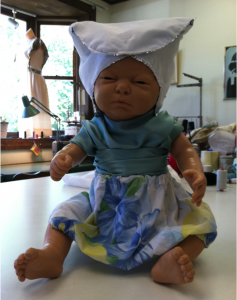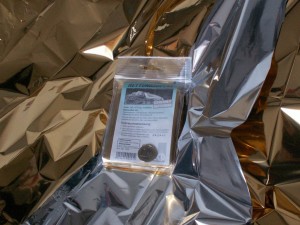
Clinical innovations don't have to be complex. Sometimes, as nurse Karen Sakakeeny has found, an innovation can be as simple as a hat (shown here on a doll). (Courtesy Karen Sakakeeny)
When we think about innovation, especially in health care, our thoughts often turn to the highly complex: new surgical procedures, new drugs, new devices or machines, etc.
But innovation in medicine and patient care doesn’t have to be complex. Sometimes it can be very simple. Like a hat.
Karen Sakakeeny has been a clinical nurse for more than 30 years, spending much of that time in the operating room. While doing a stint in cardiac surgery, she found herself thinking about ways to improve the rewarming process for infants undergoing open heart surgery.
During surgery, infants on cardiac bypass are cooled down to about 82° Fahrenheit. This slows their metabolism and helps prevent damage to the heart muscle. After the surgical repair is complete, the OR team starts to rewarm the child, typically with a heated mattress, warmed fluids, adjustments to the bypass machine, and by turning up the thermostat in the operating room.
Still, it can be difficult to achieve and maintain an optimal body temperature. And then there is the trip to the cardiac ICU. “The hallways between the operating room and the ICU are cool, and the ICU itself is cool,” says Sakakeeny. “It’s hard for us to bring the child’s temperature up when we keep moving them from one cool space to another.”
While working on a project on evidence-based practice, Sakakeeny decided to study the rewarming problem. Her epiphany came when thinking about an opposite situation. “If we need to cool an infant further, we often place ice packs around their head,” she says. “I suddenly said to myself, ‘If we cool them down this way, can we also use the head to help warm them up?’”
Sakakeeny’s epiphany was followed by a eureka moment. “We always tell our own kids to put a hat on to stay warm,” she says. Indeed, as much as 60 percent of an infant’s body heat can be lost through the scalp, and the clinical literature champions using hats to maintain infants’ body temperature. “We often put hats on children in the hospital in other settings to help them stay warm. So maybe what we need is a hat.”
Putting the idea into practice
While the idea may be simple, it can be a long road to putting it into practice, an experience Sakakeeny related at a recent Innovation Acceleration Program (IAP) Innovators’ Forum, monthly gathering of the Children’s innovation community where resources and ideas are shared..
She started by trying a simple change in practice, using a regular knit hat in the OR. But that didn’t work: “To put a regular hat on an infant when it’s time to rewarm, we would have to move them, and that would disrupt the surgical field,” she explains. “Also, because infants are so small, IV lines are often placed in the scalp. A regular hat gets in the way.”

Mylar helps hikers and marathon runners retain their body heat. Can it help do the same for infants in the OR? (Markus Brunner/Wikimedia Commons)
Sakakeeny went to the drawing board to come up with something new. “I realized we needed something made of a material that helps regulate temperature. Something with flaps that could be spread out unfolded on the OR table before surgery. That way we could position the child’s head on top of the hat when we bring them into the OR and, when it came time to rewarm them, we could just close the flaps.”
“This still gives the anesthesiologist access to the scalp,” says Sakakeeny. “And if the child starts to get too warm, we can open up one of the flaps.”
The next hurdle: data. “The Technology & Innovation Development Office (TIDO) helped me file a provisional patent application and found several companies potentially interested in producing the hat. But the companies wanted to see clinical data before moving forward,” says Sakakeeny. “I’m a clinical nurse; I was out of my comfort zone.”
It all came together after Sakakeeny applied for and received an IAP Innovestment Grant. “The grant was the last part of the puzzle. It gave me both credibility and financial support, and opened up all kinds of doors, including help from nurse scientists on the Cardiovascular Critical Care team with designing and submitting a study to the Institutional Review Board.”
The grant also gave her the support she needed to make a prototype. “I’ve gone to and been friends with a pair of seamstresses for years. I approached them with a sheet of Mylar and asked for their help in making a prototype. We spent hours brainstorming ideas and designs, using a doll to figure out the right shape and size.” Together, they came up with a three-flap design in four sizes that uses Mylar with a cotton backing and Velcro to hold the flaps together.
With her patent pending, and her protocol to test the effectiveness of the hat under IRB review, Sakakeeny has high hopes. In her eyes, the hat could have very broad use. “I envision that we could use this in just about any situation where you need to keep a newborn or premature infant warm,” she says.
“In the end,” she concludes, “what amazes me still is that it’s just a hat.”







